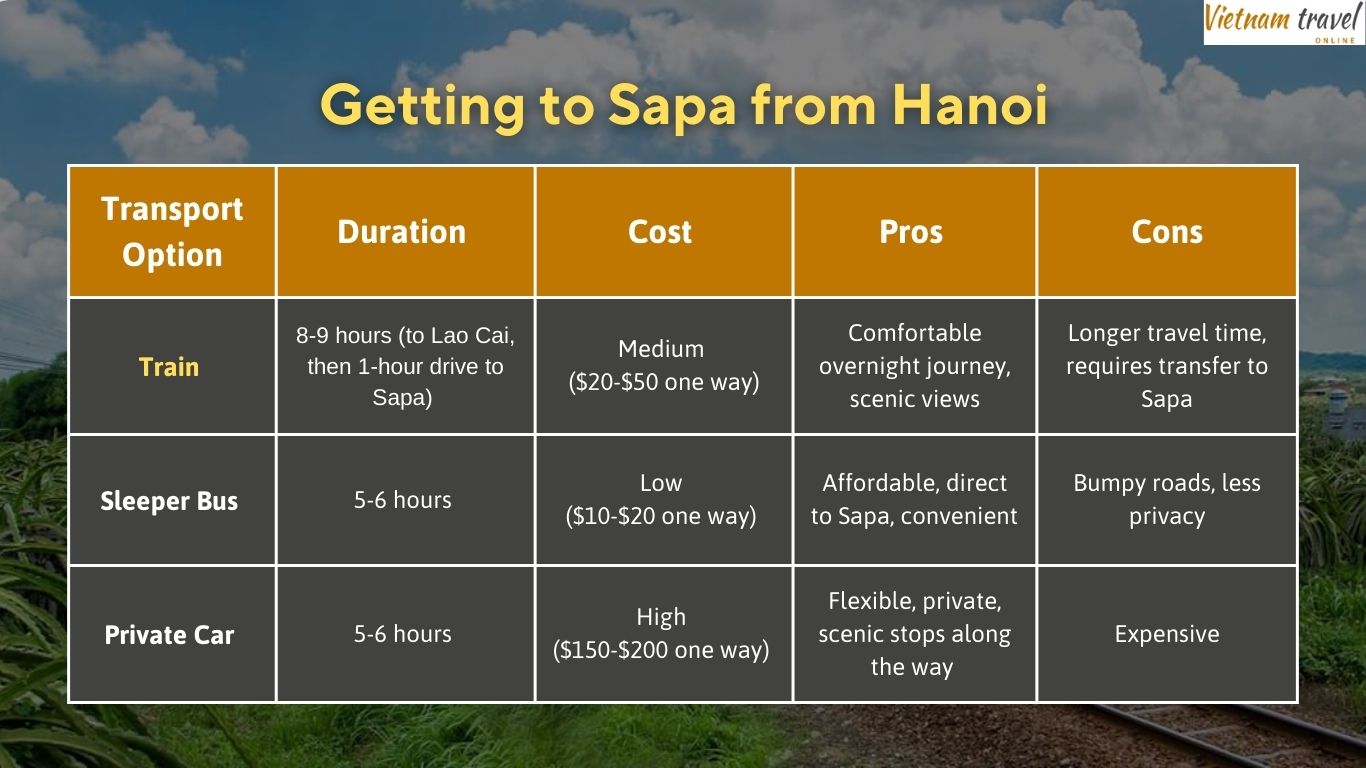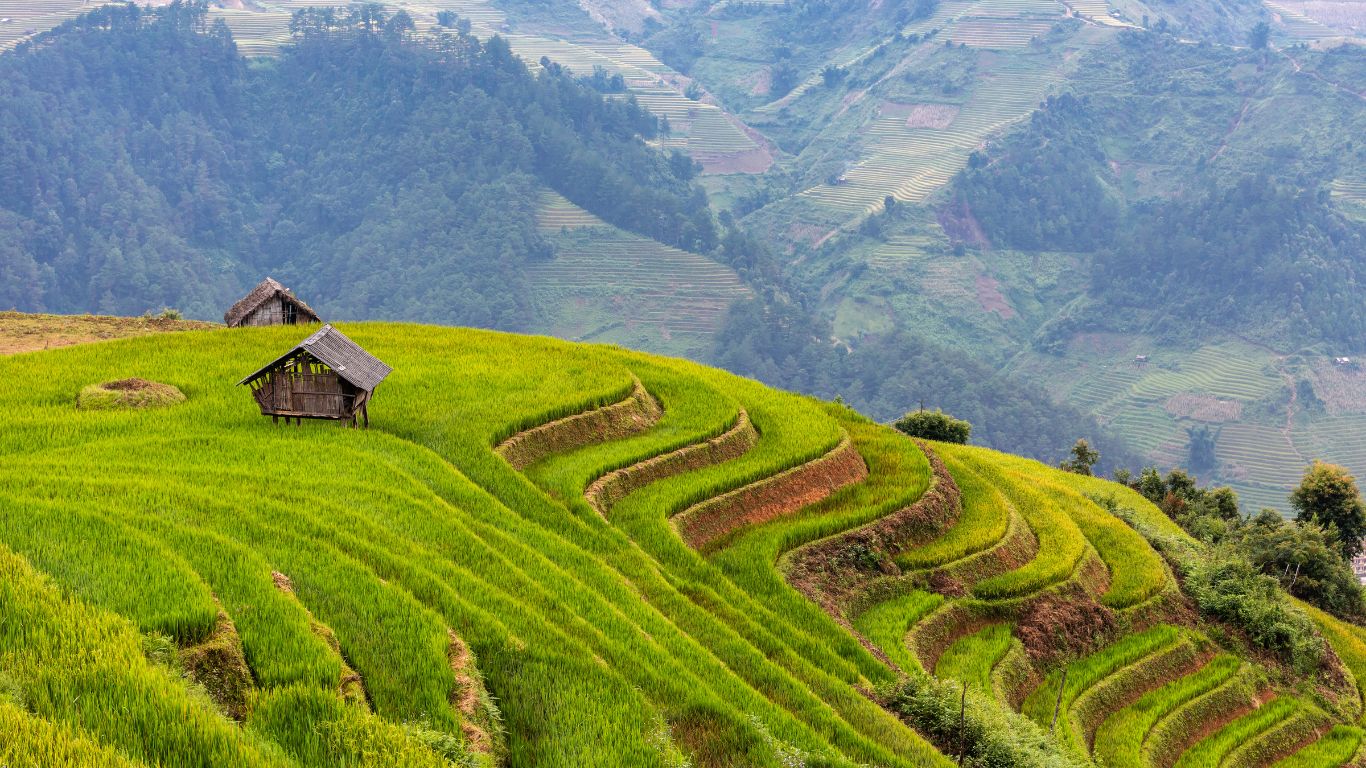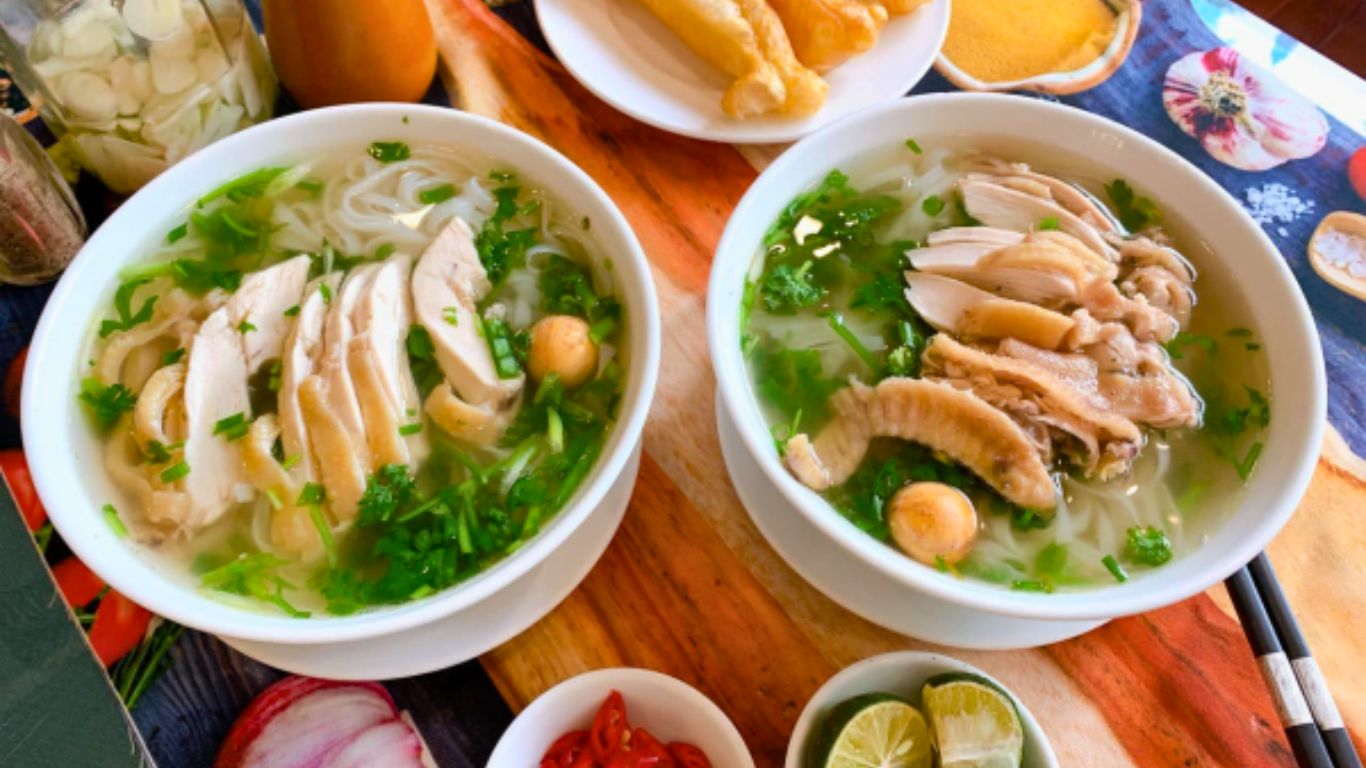To travel from Hanoi to Sapa, you can take a train, bus, or private car. Night train can be the best way to travel at an affordable price and comfortably, the sleeper bus is the best option for budget travelers, and private car for flexibility. The ideal time to visit is between March to May or September to November. In this guide, we also recommend a 5-day itinerary, providing the perfect balance to explore both Hanoi and Sapa without feeling rushed.
How far is it from Hanoi to Sapa?
The distance from Hanoi to Sapa is about 320 kilometers (200 miles). While it’s not very far, the roads to Sapa are winding and take you through mountainous areas, which can make the trip last about 5-6 hours. Depending on how you like to travel, there are different ways to make the journey – some are faster, some more comfortable, and some cheaper.
Tip: If you get motion sickness, pack some ginger tea or candies. The winding mountain roads can be challenging, and these natural remedies really help.
How to get from Hanoi to Sapa?
When planning your trip from Hanoi to Sapa, there are three main ways to travel: by train, sleeper bus, or private car. Each option offers different experiences, depending on your budget and comfort preferences. Below is a quick comparison to help you decide which mode of transport suits your journey best.

By train
Traveling by overnight train can be the best way to go from Hanoi to Sapa. The train doesn’t go directly to Sapa, but it stops in Lao Cai, which is about 35 kilometers (22 miles) from Sapa. The train ride takes around 8-9 hours, so most people take the evening train and sleep through the night.
Once you reach Lao Cai in the morning, you can take a bus or taxi to Sapa. This option lets you enjoy a relaxing night while also saving a night’s stay in a hotel.
Local tip: Try to book a soft sleeper cabin for more comfort. Book a berth (bed) in the VIP cabins of Sapaly or Chapa Express. They cost about $35-$45 per person but offer more comfort and privacy than standard cabins.

By sleeper bus
If you want a faster and more affordable option, take a sleeper bus, costing around $10-$20. The bus ride lasts about 5-6 hours, and it takes you straight to Sapa, so there’s no need for extra transportation. These buses are equipped with reclining seats that allow you to sleep comfortably during the journey. Just be prepared for some bumpy roads once you get into the mountains.
Helpful tip: Bring some motion sickness medicine if you’re sensitive to winding roads.

By private car
For the most flexible and comfortable option, you can hire a private car, which costs about $150-$200. This way, you can travel at your own pace and even stop along the way to take pictures or enjoy the views. The drive takes about 5-6 hours, and it’s a good choice for families or small groups.

The best time to visit Hanoi and Sapa
March to May
During this time, Sapa is full of blooming flowers, and the weather is cool and dry, perfect for trekking. In Hanoi, the weather is also pleasant, making it a great time to explore the city’s attractions like the Old Quarter and Hoan Kiem Lake.
September to November
In Sapa, this is the harvest season, and the rice terraces turn golden, making the scenery absolutely breathtaking. The comfortable temperatures are also perfect for trekking. In Hanoi, the weather is cooler and more comfortable, making sightseeing and exploring enjoyable.
Insider tip: September is the best month to see the golden rice fields in Sapa.

Suggested Hanoi Sapa itinerary in 5 days
If you have 5 days, this itinerary will give you a balanced mix of exploring both Hanoi and Sapa, ensuring you get the best experiences from both places.
Day 1: Hanoi
After arriving in Hanoi, take the day to settle in and explore the city. Stroll around Hoan Kiem Lake, explore the bustling Old Quarter, and enjoy some local street food like pho or banh mi. Take it easy today as you adjust to the city’s rhythm.

Day 2: Hanoi City Tour – Night train to Lao Cai
Start with a visit to the Ho Chi Minh Complex and the historic One Pillar Pagoda. Then, explore the Temple of Literature, Vietnam’s first university, followed by a stop at the Ethnology Museum to learn about the country’s diverse cultures.
In the afternoon, stroll through the bustling Old Quarter, and end your day with a night food tour, sampling delicious local dishes before boarding the night train to Lao Cai for your journey to Sapa.
>>> Blog you might find helpful: Best things to do in Hanoi & Tips to beat the tourist crowd

Day 3: Lao Cai – Sapa – Cat Cat Village
Once you arrive in Lao Cai, take a bus or taxi to Sapa. After checking in to your hotel, head to Cat Cat Village, a traditional H’mong village surrounded by beautiful rice terraces and waterfalls. It’s a great introduction to the natural beauty of Sapa.
Day 4: Sapa – Lao Chai – Ta Van – Lao Cai – Hanoi
This is your trekking day! Start by exploring the Muong Hoa Valley and visit Lao Chai and Ta Van villages. You’ll pass through amazing rice terraces and meet local ethnic minorities. In the evening, return to Lao Cai to catch the night train back to Hanoi.

Day 5: Hanoi
On your last day in Hanoi, you can explore any spots you missed or revisit your favorite places. If you have time, check out the Ethnology Museum to learn more about Vietnam’s diverse cultures.
Tour ends. You are ready for the next destination or to fly home.
>> Find your package tour to Sapa from Hanoi: Hanoi Sapa itinerary 5 days
Note: The itinerary will be customized to match your travel preferences since we offer PRIVATE TOURS to Vietnam and Indochina countries. To get a quote and detailed proposal from our travel expert, contact us here or email at vietnam@indochinavoyages.com.
FAQs
Is it necessary to book tours or can I explore on my own?
You can explore Sapa on your own as it’s easy to get around and many routes are well-marked. However, joining a tour can give you more insights into local culture and history, especially when visiting remote villages.
Is it safe to travel in these areas?
Yes, Hanoi and Sapa are safe for tourists. Just take normal travel precautions, like keeping an eye on your belongings. In Sapa, it’s important to follow safety guidelines when trekking and respect local customs in villages.
How many days should you spend on a Hanoi – Sapa trip?
A 5-day trip is ideal for visiting both Hanoi and Sapa without feeling rushed. You’ll have time to explore the highlights and enjoy the beautiful landscapes. If you have more time, you can easily extend your stay to relax or see more places.
Are Lao Chai and Ta Van villages worth visiting?
Definitely! These villages offer a real look at local life, and the views along the way are breathtaking. Visiting these places allows you to interact with local ethnic minorities and see their traditional ways of living.
How physically demanding are the treks in Sapa?
The treks in Sapa range from easy to moderate. Most people can manage them, even without much trekking experience. However, be prepared for some uneven terrain, and wear sturdy shoes.
What kind of weather should I prepare for in Sapa?
Sapa’s weather can be unpredictable, so it’s good to bring layers. The mornings and evenings can be cool, while afternoons may be warmer. If you visit during the rainy season (June to August), a rain jacket is a must.
In conclusion, planning your trip from Hanoi to Sapa can be both exciting and seamless with the right itinerary and travel options. Whether you choose to travel by train, bus, or private car, the journey will offer stunning views and unforgettable experiences. With our suggested 5-day itinerary, you’ll have enough time to explore both destinations at a comfortable pace. If you looking for more ideas about the Vietnam tour packages, just click here.






